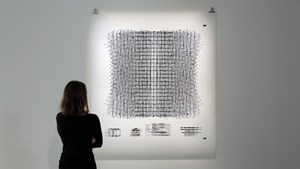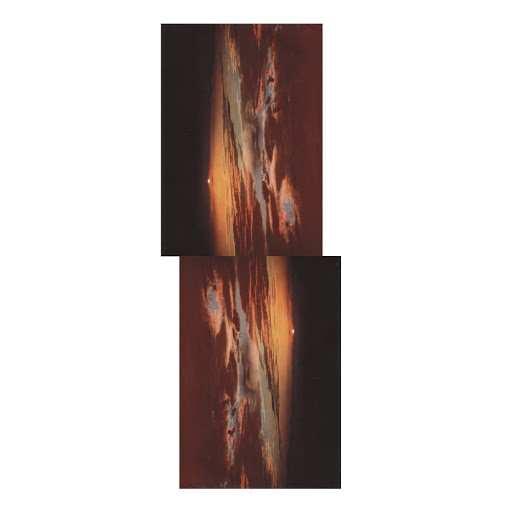
It seems that in recent years, we’ve been looking and even longing for the stars like we haven’t in decades. NASA announcements and films as Avatar, Gravity, Interstellar and The Martian reached millions of eager people. Have we, in spite of our optimism and belief in technological possibilities, abandoned all hope for our home, plagued as it is by continual crises and human pollution? Are we unconsciously searching for a new one in outer space?
It seems that in recent years, we’ve been looking and even longing for the stars like we haven’t in decades. NASA announcements and films as Avatar, Gravity, Interstellar and The Martian reached millions of eager people. Have we, in spite of our optimism and belief in technological possibilities, abandoned all hope for our home, plagued as it is by continual crises and human pollution? Are we unconsciously searching for a new one in outer space? In any case, the cosmos is a hot topic, in popular culture and to some extent in art. As a blogger noted, space and astronomy was a ‘distinct trend’ at last year’s London Art Fair. Jonny Nyles showed graphite on paper drawings, Nicholas Portalupi had sci-fi-based collages dedicated to space travel, Geoff Diego presented laser engraved oil on gesso of archival astronomical imagery, and Nicolai Howalt’s black and white inkjet prints re-appropriated NASA imagery.
His favourite artist however was Caroline Corbasson, a stellar name in that small realm of contemporary art. Only 26, her work has already been exhibited both in France and abroad and it is easy to see why so many find it appealing. Her exploration of the cosmos and the way it has been represented and shown to us over time is as accessible as it is fresh and perplexing. But her imagination isn’t limited to the infinite vastness that envelops our planet, it is also keen on science in general – although her interests are constantly developing, as she explains in this interview. So far key themes in her work have been the shortcomings of even our most advanced scientific knowledge and the shifting role of aesthetics in communicating that knowledge. Caroline Corbasson was there first artist we highlighted in our short interview series 10 questions. Here, she gives more insight into who she is and how she looks at the world – and beyond.
Naked Eye (2014) (screen print, 180x150 cm)

Dust to Dust (2012) (astral dust and spraypaint on paper mounted on MDF, 2x 190x75 cm)
Artdependence Magazine: How has the past year been for you?
Caroline Corbasson: Workwise, it has been a good one. I feel grateful. Two solo exhibitions – one in Paris, the other in Geneva – and many group exhibitions have kept me very busy. I didn’t have much time to stop and think, which was great to some extent, but now I feel I need to slow down and concentrate on new work. I want to deepen my researches and take some time to visit places – this week, the Laboratoire Astrophysique de Marseille. Exhibitions are energy-consuming and right now I want to make sure that all my energy goes back into my work again. I’m eager to be an artist-in-residence in La Baule from March until May, as it is by the sea and has a large working space where you can experiment with new things. Showing my work often has given me a clear insight into what I want to achieve and what I don’t want anymore.
AD: How was the response on your exhibition in Geneva?
CC: Empty Pixels was my first foreign solo exhibition, so it was exciting. The response surprised me. I didn’t expect such a warm welcome. A lot of people came to the opening and the discussions around my work were so intense that they made me grow. There were even some physicians from the CERN!
AD: Are you someone that thrives on recognition or are you paralyzed by it? And do you feel any pressure to continue to meet expectations and to keep evolving?
CC: This is a tricky one. I do feel a lot of pressure, but it tends to be the stimulating kind. Since I’m hardly ever satisfied with what I do, my main concern is to keep evolving and to stay focused. I think recognition becomes paralyzing when it is a goal in itself. It should only come after working very hard, when it’s deserved.

Atlast (2013) (detail) (collage, two identical pages from Becvar’s cloud atlas, 2x 21x30 cm)

Signals (Sending signals to vast emptiness and waiting for a reaction, April 2014) (fine art prints on Hahnemühle paper, 2x 30x40 cm)
AD: What ignited your fascination for space?
CC: Space has and will always be an object of fascination. What intrigues me in particular is how we speak about it, the limits of representation, the missing parts and the boundaries between art and science. Travelling a lot as a child probably triggered my love for observation, and this love was later intensified by meeting scientists. I recently discovered that my grandfather collaborated with NASA on optical researches – he’s an engineer. My father also works in optics. Vision and observation instruments have therefore always been an important part of my life.
AD: You spent your childhood in Canada. Do you go back often?
CC: Unfortunately, I only went back once, but I miss it a lot. It still feels like home somehow. Nature is undergoing many changes and I hope art can be a way to raise awareness about it. Not in a didactical way, but simply by inviting people to connect with it again. We tend to forget how essential it is to pay attention to all the details. I have good faith in the promise of Justin Trudeau, Canada’s new prime minister, to increase the funding for the arts. Let’s just hope they’re more than mere promises. Once in effect, they will no doubt trigger a virtuous circle.
AD: The cosmos is for the most part undiscovered. Do you feel you still have a lot to discover in the subject ‘space’ as an artist?
CC: I feel like I will never get tired of exploring it, although I also want to explore radically different subjects. Going back and forth can create interesting points of view. For instance, at the moment I’m interested in the aesthetics of fabrication processes in mass production factories and construction sites. Regarding space, I am curious about how new technologies will make all the present images obsolete. I’ve been following the development of the James Webb Space Telescope, with its incredible mirror spanning 6.5 meters. It will be launched in 2018 and I’m impatient to discover the new data.

Noise (2015) (fine-art print on Hahnemüehle paper, 105x75 cm)

Plage (2015) (3D animation, 1'40 loop, sound Gustave Rudman)
AD: NASA made some thrilling announcements recently. First Philae, then Mars and Pluto. Is new data like a shot of adrenaline to your practice as an artist?
CC: It has been interesting to observe how these new images also invade social media. Everyone seems to agree on how thrilling the achievements are and how they put everything into perspective. I follow these events with a lot of enthusiasm of course, but my practice isn’t particularly based on the most recent ones.
AD: And what about critical and popular film hits such as Gravity, Interstellar, and The Martian?
CC: I really enjoyed watching these films, mostly because the special effects are breath-taking. Though I must say my expectations were so high I couldn’t help being slightly disappointed. The incredible technical skills are sometimes detrimental to the actual content.
AD: To you science has a poetic quality, but what about the fear that science is becoming more and more unfathomable and even dangerous for mankind and the pessimism that the universe and all our cultural riches is going to be obliterated in the end?
CC: I don’t think pessimism has ever solved anything. It all depends on how we are going to make use of this knowledge. I don’t believe science can be dangerous as long as ethics aren’t evinced. Artificial intelligence can be a wonderful thing. It’s a question of balance, harmony and responsibility. We cannot keep running into a brick wall, we must reflect on what world we want to live in before it’s too late. Culture is an indispensable condition for mankind’s fulfilment. I believe small streams make big rivers and that each person has a role to play.

Apart (2014) (charcoal on paper, 2x 105x75 cm)
![]()
Empty Pixels, Galerie Laurence Bernard, exhibition view, Comet (2015) and Anomalia (2013)

ArtDependence Magazine is an international magazine covering all spheres of contemporary art, as well as modern and classical art.
ArtDependence features the latest art news, highlighting interviews with today’s most influential artists, galleries, curators, collectors, fair directors and individuals at the axis of the arts.
The magazine also covers series of articles and reviews on critical art events, new publications and other foremost happenings in the art world.
If you would like to submit events or editorial content to ArtDependence Magazine, please feel free to reach the magazine via the contact page.